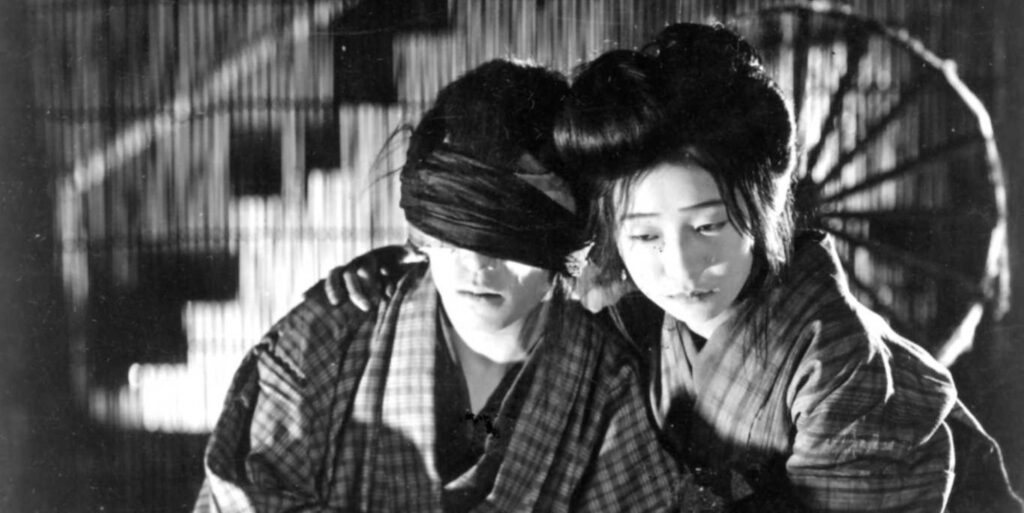TEINOSUKE KINUGASA: FROM SHADOW TO LIGHT

Curated by Alexander Jacoby and Johan Nordström. Co-organizer: National Film Archive of Japan
The distinguished director Teinosuke Kinugasa (1896-1982) stands in a paradoxical relationship to international cinephilia. Jujiro (Crossways, 1928) was one of the first Japanese films ever to be screened in the West, and Jigokumon (Gate of Hell, 1953) scooped the Palme d’Or at Cannes as Japan’s cinema won a broader global audience. Kurutta ichipeiji (A Page of Madness, 1926) was hailed as an avant-garde masterpiece after its rediscovery in the 1970s. Yet Kinugasa’s wider oeuvre, which spanned more than four decades and comprised more than 100 films, in a rich variety of genres, is still barely known abroad.
Kinugasa entered the film industry as an actor – a female impersonator (onnagata) at a time when women’s roles were still played by men. This biographical fact has particular interest in the light of Yukinojo henge (An Actor’s Revenge, 1935), the protagonist of which is an onnagata in the kabuki theatre. In the early 1920s, as studios moved towards the use of actresses, Kinugasa began his directorial career. During the silent era he worked at Makino Pro, the company established by pioneering filmmaker Shozo Makino, as well as producing his experimental silent films, Kurutta ichipeiji and Jujiro, independently (albeit with some support from Shochiku). Thereafter he worked successively at three of Japan’s major film studios, Shochiku, Toho and Daiei, crafting mainstream films which achieved, at their best, critical prestige as well as commercial success.
Kinugasa’s work ranges from high-quality literary adaptations, to films about the performing arts, to unusual period dramas that largely eschew violent action in favour of sophisticated historical analysis and intense personal drama. He was an auteur who scripted or coscripted almost all his own films; his Daiei colleague Akinari Suzuki claimed that “Kinugasa’s scripts were not thought out in the mind by a scriptwriter, but visualised in the eyes of a director”. According to another Daiei colleague, screenwriter Kazuo Funahashi, he would physically act out the images he envisaged while his collaborators “desperately tried to commit it all to paper”. As such anecdotes suggest, Kinugasa was an imaginative stylist, whether essaying monochrome expressionism or colour pictorialism. For Japanese critics, he is the master of closeups, as Mizoguchi is the master of long shot. He was also a skilled director of actors, who maintained longstanding collaborations with some of Japan’s greatest stars, including Chojiro Hayashi (later Kazuo Hasegawa) and Fujiko Yamamoto.
Drawing on recent restorations as well as vintage prints, this retrospective will balance the silent classics with neglected works from the sound era, helping a significant body of work to emerge from the shadows of film history.
Alexander Jacoby and Johan Nordström
Program
Saturday 24/06/2023
17:45
Jolly Cinema
DAIBUTSU KAIGEN
DAIBUTSU KAIGEN
Alexander Jacoby and Johan Nordström
Sunday 25/06/2023
18:15
Jolly Cinema
KURUTTA ICHIPEIJI / Oni azami
KURUTTA ICHIPEIJI / Oni azami
Mika Tomita (National Film Archive of Japan)
Gabriel Thibaudeau and violin accompaniment by Silvia Mandolini
Sunday 25/06/2023
21:30
Jolly Cinema
SHIRASAGI
SHIRASAGI
Monday 26/06/2023
18:30
Jolly Cinema
YUKINOJO HENGE
YUKINOJO HENGE
Tuesday 27/06/2023
18:30
Jolly Cinema
JUJIRO
JUJIRO
Alexander Jacoby e Johan Nordström
Donald Sosin
Tuesday 27/06/2023
21:30
Jolly Cinema
DAIBUTSU KAIGEN
DAIBUTSU KAIGEN
Wednesday 28/06/2023
21:30
Cinema Lumiere - Sala Scorsese
JOYU
JOYU
Thursday 29/06/2023
18:10
Jolly Cinema
SHIRASAGI
SHIRASAGI
Thursday 29/06/2023
21:30
Jolly Cinema
KURUTTA ICHIPEIJI / Oni azami
KURUTTA ICHIPEIJI / Oni azami
Meg Morley
Friday 30/06/2023
17:00
Jolly Cinema
KAWANAKAJIMA KASSEN
KAWANAKAJIMA KASSEN
Alexander Jacoby and Johan Nordström
Saturday 01/07/2023
18:30
Jolly Cinema
YOSO


